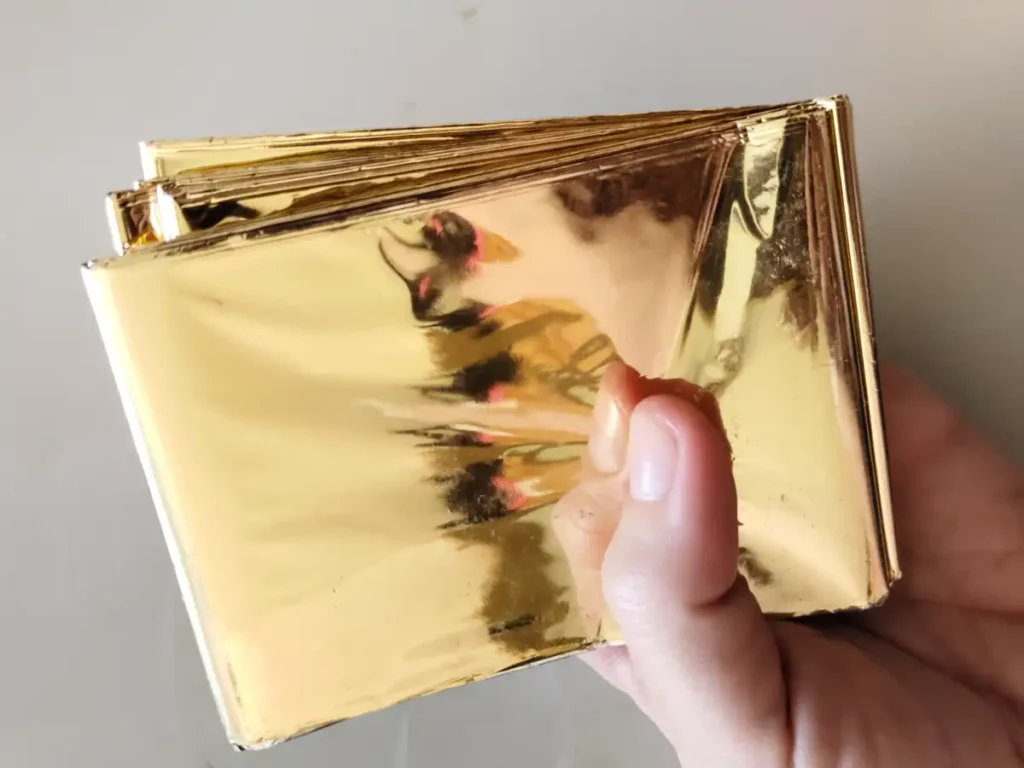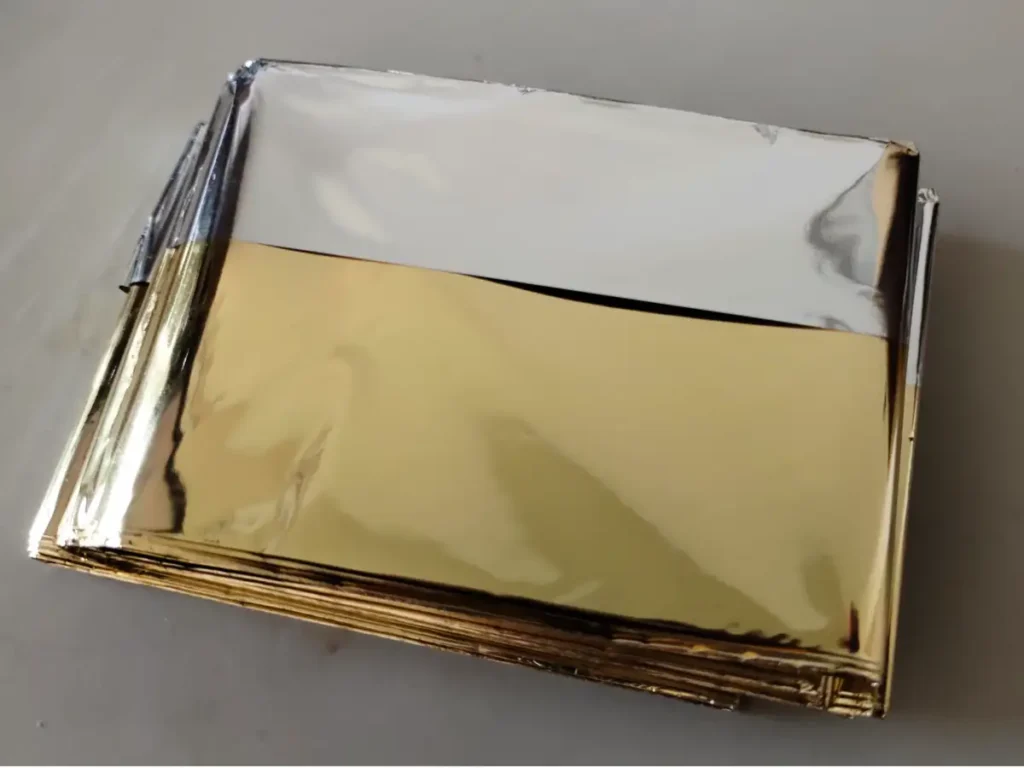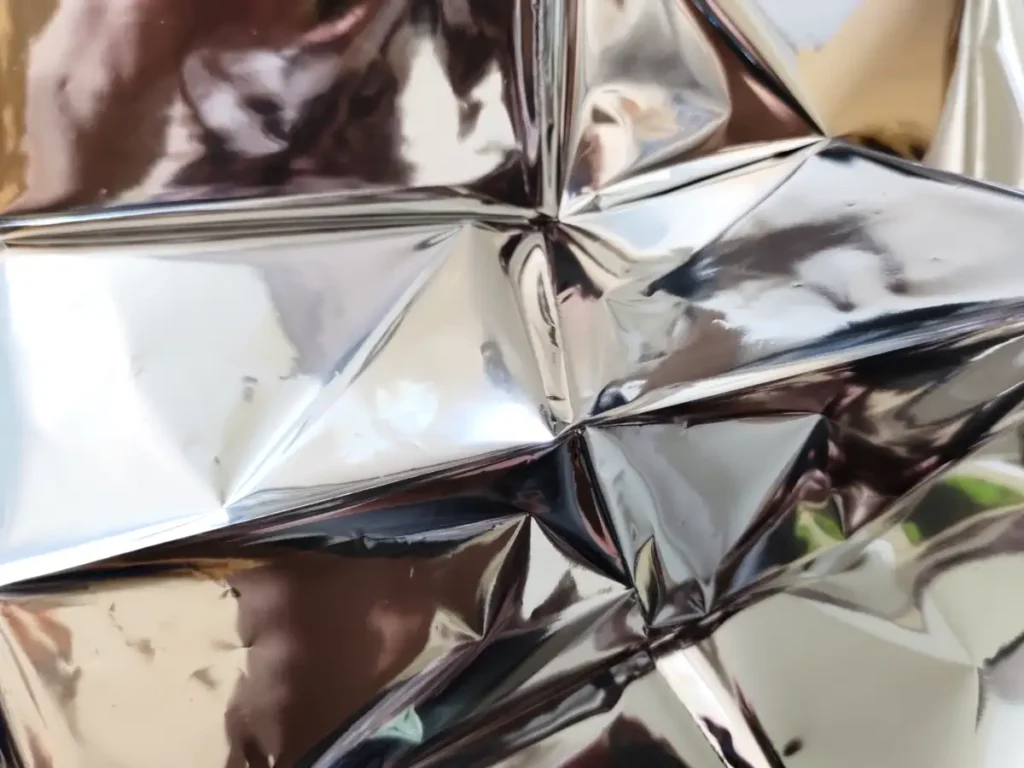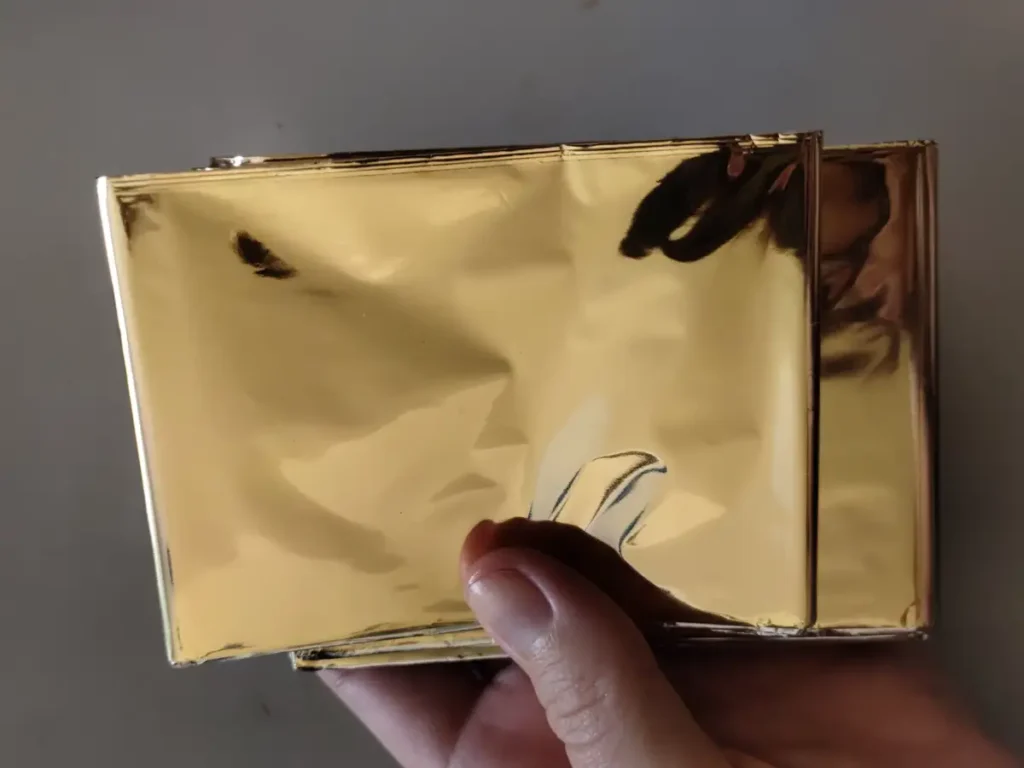How to use an emergency blanket: Which side goes up?
This post may contain affiliate links. This means that we may receive a small commission from purchases through those links. Read more in our affiliate disclosure.
The emergency blanket is a lightweight, versatile and often overlooked survival tool that should always find a spot in your backpack.
So why should hikers always carry an emergency blanket? Well, in an emergency, it can be used to retain body heat, create a makeshift shelter, signal for help, and even collect rainwater. In essence, it’s a multipurpose tool that can be a lifesaver in a variety of situations. Plus, its compact size and lightweight nature mean it takes up minimal space – you’ll hardly notice it’s there until you need it.
In a nutshell: Silver side of an emergency blanket facing your body keeps you warm; Gold side facing your body keeps you cool.

In this post, we’ll dig into the nitty-gritty of emergency blankets: what they are, how they work, and, crucially, how to use them correctly – because, as with any tool, knowing how to use them makes all the difference. We’ll explore its various uses, from keeping warm to signaling for help, and address some common questions about this versatile survival aid.
- Introduction
- What is an Emergency Blanket?
- How do Emergency Blankets Work?
- How to Use an Emergency Blanket Correctly
- Other Uses of Emergency Blankets
- Signal Mirror
- Gear Protection
- Rain Poncho
- First Aid
- Fire starter
- Fire Heat Booster
- Sun Shield
- Rain Tarp / Shelter
- Rain Collector
- Makeshift Solar Still
- Socks
- Rope
- Fishing Lures
- Window Reflectors
- FAQ: Emergency Blankets
- Conclusion
What is an Emergency Blanket?
An emergency blanket, also known as a survival blanket, space blanket, thermal blanket, Mylar blanket, or foil blanket, is a very thin, shiny sheet, which can be folded up compactly.
Originally developed by NASA in 1964 for the US space program, the idea was to protect spacecraft and astronauts from the harsh extremes of space. The material had to be lightweight, compact, and efficient at controlling temperatures – both protecting from the cold of space and the heat of the sun.

Space blankets are made from a very thin plastic sheet, typically polyethylene, coated with a metallic reflecting agent, usually aluminum. Often emergency blankets have a silver side and a golden side.
This combination of materials is chosen for several reasons. Firstly, polyethylene is strong yet lightweight, making it easy to carry without adding significant weight to your pack. Secondly, the metallic coating is crucial for its reflective properties – more on that in a bit.
How do Emergency Blankets Work?
An emergency blanket typically has two sides with different properties and uses:
- Silver Side: The silver side, coated with aluminum, is highly reflective to both visible light and infrared radiation. Infrared radiation is essentially the heat that is emitted by warm objects such as our bodies, fires, or the sun.
- Gold or Orange Side: The gold side reflects less heat radiation, which keeps the space it faces cooler. Another advantage is visibility; the color stands out against most natural backgrounds, making it ideal for signaling in emergency situations.

To understand why survival blankets work so well, we first need to understand how we get cold in the first place. Our bodies lose heat in four ways:
- Convection: This is the process of heat being carried away by the movement of gases or fluids, which in most outdoor scenarios refers to air or water. Imagine a breeze whisking away your body heat on a windy mountain top.
- Conduction: This is direct heat loss through physical contact with a cooler surface. For instance, lying on the cold, hard ground can rapidly drain your body heat.
- Evaporation: When your body sweats or gets wet, heat is lost as the moisture evaporates. This is a cooling process that can be dangerous in cold conditions.
- Radiation: Our bodies constantly emit heat in the form of infrared radiation. Normally, this heat radiates away into the environment. Similarly, the infrared radiation emanating from the sun or a fire can heat you up – for example, most of the heat you feel when sitting next to a fireplace is due to radiation.
A space blanket, amazingly, helps with three of these:
- An emergency blanket acts as a windbreaker, trapping a layer of air around your body. This trapped air is warmed by your body and forms an insulating layer, reducing heat loss through convection.
- Space blankets also trap sweat and water, and as such prevent the cooling effect of evaporation. However, it’s important to manage perspiration, as accumulated moisture inside the blanket can become counterproductive.
- The metallic surface of a foil blanket reflects infrared radiation back towards your body, significantly reducing heat loss. Alternatively, you can use the blanket to reflect infrared radiation from a fire towards you, or the sun’s radiation away from you. This reflective property is the same reason astronauts’ space suits and spacecraft are lined with similar materials – to manage the extreme temperatures of space.
Thanks to this multitude of effects, foil blankets are incredibly useful in managing your temperature – we’ll go over various ways to use them below.
How to Use an Emergency Blanket Correctly
Which Side of the Emergency Blanket to Use for What?
When it comes to emergency blankets with a gold and a silver side, each color serves a specific purpose, optimizing the blanket’s functionality in different scenarios.
Face the Silver side inwards to stay warm
When your primary goal is to retain body heat, use the silver side towards your body. Silver is excellent at reflecting body heat back towards you, reducing heat loss via radiation. The gold side, facing outward, can help a bit by absorbing some environmental heat, but its primary function in this scenario is more about being visible for rescue.
Face the Gold side inwards to stay cool
In hot conditions, where the goal is to deflect sunlight and reduce heat absorption, the silver side should face outward. Silver reflects sunlight more efficiently, helping to create a cooler space underneath the blanket. This is especially useful in desert environments or open areas with intense sun exposure.
Use the Gold Side outwards to be visible
If you’re in a situation where you need to signal for help, having the gold side facing outward can be more effective. The gold side is typically brighter and more visible than the silver side, especially in environments where silver might blend in with the surroundings, like snowy landscapes.
How to Use a Space Blanket for Warmth While Staying Put
When you’re not moving, like during rest periods or overnight, wrap the blanket around you with the silver side facing inward. The objective is to create a ‘heat cocoon’ that reflects your body heat back towards you. It’s important to wrap it snugly but not so tight that it leads to discomfort or excessive sweating, as moisture build-up can reduce the blanket’s effectiveness. It’s best if you trap a layer of air between yourself and the blanket for extra insulation. If you’re lying down, place an insulating layer like a sleeping pad or a pile of dry leaves between you and the ground to minimize heat loss through conduction.
How to Use a Survival Blanket to Stay Warm on the Move
Staying warm while moving can be tricky, as you need to balance warmth with the need for mobility and managing perspiration. Drape the blanket over your shoulders like a cape, with the silver side facing your body. This allows for movement while keeping your core warm. Be aware of your activity level – if you start to sweat, adjust the blanket or remove it temporarily to avoid moisture build-up. In the rain, you can use the emergency blanket to also keep you dry, by cutting a hole in the middle for you head, and wearing it like a poncho.
How to Use an Emergency Blanket to Stay Cool in the Sun
Using an emergency blanket to stay cool in the sun involves leveraging its reflective properties to deflect sunlight away from you and reduce heat absorption. Here’s how to do it effectively:
- Position the Blanket: For maximum efficiency, drape or suspend the blanket above you, creating a makeshift shade. Ensure the silver side faces the sun. This orientation maximizes the reflection of sunlight and its associated heat, acting as a barrier that reduces the amount of heat reaching you.
- Create Airflow: While reflecting sunlight, it’s also important to allow for airflow. If possible, don’t let the blanket touch you directly. Instead, create a small shelter or canopy by securing the blanket to trees, rocks, or any available support. This setup helps in creating a shaded area while allowing air to circulate, preventing the space underneath from becoming too hot.
- Avoid Direct Contact: If you have to wrap the blanket around you for sun protection (for instance, if you’re moving), try to maintain a layer of air between your skin and the blanket. Direct contact can lead to increased perspiration and discomfort, counteracting the cooling effect. You could attach the blanket to your hat, such that it loosely drapes around you, allowing for airflow while protecting you from the solar radiation.

Other Uses of Emergency Blankets
Emergency blankets are not just for warmth or sun protection; they can be versatile tools in various survival situations. Let’s explore some of these ingenious uses.
Signal Mirror
In emergency scenarios, being seen can mean the difference between life and death. The reflective surface of a Mylar blanket makes an excellent makeshift signal mirror. You can use it to reflect sunlight, creating flashes that can be seen from a distance. This is particularly useful if you’re lost or injured and need to attract the attention of rescuers or passersby. The key is to aim the reflections at potential rescuers, using the blanket to send a visible SOS.
Gear Protection
Emergency blankets can serve as protective covers for your backpacks and other equipment during unexpected rain showers or overnight dew. They are water-resistant and can help keep your gear dry and functional.
Rain Poncho
Speaking of rain, a space blanket can be fashioned into a makeshift poncho. Cut or tear a hole in the middle for your head, and drape it over your body. This can keep you dry in sudden downpours, and the reflective material can also help retain body heat in cooler temperatures.
First Aid
In first aid situations, emergency blankets an be used to prevent or treat hypothermia by wrapping them around a person to conserve body heat. Additionally, they can also be used to immobilize limbs or as a makeshift sling.
Fire starter
Believe it or not, the reflective surface of a survival blanket can be used to focus sunlight onto a small point, much like a magnifying glass, to start a fire. This requires some skill and patience but can be a lifesaver in survival situations where traditional fire-starting methods are not available. This is done by creating an approximately parabolic shape with the silver side facing inwards, pointed at the sun.
Fire Heat Booster
Similarly, you can use a thermal blanket to reflect heat from a fire towards a specific area or to help retain heat within a shelter. By setting up the blanket on the wall behind a fire (at a safe distance so that the plastic sheet won’t melt), the reflective side facing the fire, it directs more heat towards you or your shelter.
Sun Shield
In excessively sunny and hot environments, a space blanket can be used to create a sun shield for your face or head, reflecting the sun’s rays away and reducing the risk of sunburn or heatstroke.
Rain Tarp / Shelter
The sturdy material of an emergency blanket makes it suitable for creating a makeshift shelter or tarp. By stretching and securing it above you, it can provide a temporary refuge from rain or sun.
Rain Collector
In a survival situation, finding drinking water is paramount. You can use a foil blanket to collect rainwater. Spread it out with a slight depression in the center to catch and funnel rainwater into a container or directly for drinking.
Makeshift Solar Still
Emergency blankets can also be used to construct a makeshift solar still, which can distill dirty water, or extract water from the soil, into drinkable water using the power of the sun.
Do this by digging a hole in the ground, and coating it with half of the blanket, silver side up. Now fill the hole with dirty water or wet material such as moss or plants, and place a water receptacle in the middle. Finally, span the other half of the blanket, gold side up, over the hole using some rocks; and place a small rock in the middle above the clean water receptacle. This set-up will trap heat inside, evaporate the dirty water, which condenses on the top sheet (which is cooled by the air above), and drips into the container in the middle. This method is very slow, but better than nothing.
Socks
In a pinch, pieces of a survival blanket can be wrapped around the feet for extra insulation. This is particularly useful if your socks are wet, and additional warmth is needed.
Rope
Strips of a Mylar blanket can be twisted or braided into a makeshift rope or cordage for various uses, such as securing a shelter or gear. Don’t trust it with your body weight, though.
Fishing Lures
Shiny pieces of a space blanket can be used as fishing lures. The light reflecting off these pieces can attract fish, making it a useful tool in survival fishing.
Window Reflectors
In hot climates, pieces of a thermal blanket can be used as reflectors in car windows to keep the interior cooler by reflecting sunlight away.

FAQ: Emergency Blankets
Q: How many times can you use an emergency blanket?
A: Emergency blankets are designed for single-use, especially in emergency situations. They can be reused if they’re not damaged, but their effectiveness might decrease with each use due to wear and tear, especially in the reflective coating. Always inspect it for rips or tears before relying on it for critical applications.
Q: How effective are emergency blankets?
A: Emergency blankets are highly effective when used correctly. They can reflect up to 90% of body heat, making them essential in preventing hypothermia. They are also effective in protecting against sun and heat when used as a sun shield. However, their effectiveness depends largely on how they are used – proper technique and application are key.
Q: Can you sleep with an emergency blanket?
A: Yes, you can sleep with an emergency blanket. It’s especially useful in cold environments to retain body heat. However, ensure that it’s snug but not too tight, to avoid excessive sweating. Using it in conjunction with other insulating materials like a sleeping pad can enhance comfort and warmth.
Q: Why are emergency blankets called space blankets?
A: Emergency blankets are called space blankets because they were originally developed by NASA for space missions. The material was designed to protect spacecraft and astronauts from the extreme temperature fluctuations in space.
Q: What’s the best way to sleep in a space blanket?
A: The best way to sleep in a space blanket is to wrap it around you with the reflective side facing inwards. Pair it with a sleeping pad or other insulating material underneath to prevent heat loss to the ground. Avoid wrapping too tightly to allow for some ventilation and prevent moisture buildup.
Q: How can a space blanket help search and rescue find me?
A: A space blanket can be used as a signaling device due to its highly reflective surface. The shiny side, especially the gold side for some blankets, can be used to reflect sunlight, creating visible signals that can be seen from a great distance, aiding search and rescue efforts.
Q: Which space blanket should I buy?
A: When buying a space blanket, look for one that’s durable, lightweight, and has high reflectivity. Some blankets come with different colored sides for specific uses, like gold and silver, which can be beneficial. Also, consider size and compactness based on your needs and the space in your backpack.
Q: Are space blankets waterproof?
A: Yes, most space blankets are waterproof and windproof. This makes them suitable for use as rain shelters or protective gear in wet conditions.
Q: Can an emergency blanket be used for first aid?
A: Absolutely. Emergency blankets can be used in first aid situations, particularly for treating or preventing hypothermia and shock. Wrapping a patient in a space blanket helps maintain body temperature, which is crucial in these conditions.
Conclusion
In the realm of hiking and outdoor adventures, the humble emergency blanket stands out as a multifaceted tool of survival and comfort. Its compact size and lightweight nature belie its vast array of uses, from providing warmth and shelter to serving as a crucial component in emergency signaling and first aid. Always point the silver side towards where you want the heat to stay – if you remember this, you’ll be fine!




